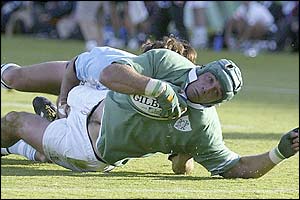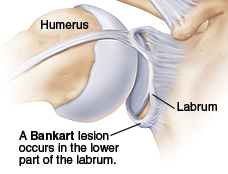How does it happen?
A shoulder dislocation is commonly associated with a direct or indirect trauma to the shoulder joint. The ball at the top of the arm bone (head of the humerus) 'pops' out of the socket (glenoid fossa) in a forward direction (anterior) (Brukner and Khan, 2007). This often results in damage to the structures at the front of the shoulder which makes it more susceptible to re-dislocation in the future (Yee et al, 1999).
Dislocations in the forward direction make up approximately 95% of all shoulder dislocations (Gartsman et al, 1995) the remainder being posterior dislocations. This usually occurs as a result of a direct blow to the arm when in a throwing like position (abducted and externally rotated) as illustrated in the picture to the right (Magee, 2008). Once the shoulder dislocates for the first time, patients often report that the shoulder never returns to normal (Magee, 2008). |  |
After a shoulder is dislocated it becomes much more susceptible to repeated dislocations. Research has found that 70% of shoulder dislocations go on to redislocate within two years (Rowe, 1956). The initial trauma caused by a shoulder dislocation may damage surrounding structures such as ligaments, tendons, nerves and may fracture bones. The damage to stabilising structures of the shoulder joint may cause instability which can lead to recurrent dislocations (Brukner and Khan, 2007).
A common injury associated with recurrent anterior shoulder dislocations is a Bankart lesion. A Bankart lesion is damage to the lower frontal (anterior-inferior) region of the socket (glenoid) which allows the arm to slip forward easier (Resch et al, 1997). Typical symptoms of a Bankart lesion include:
|  |
Laxity (looseness) as a result of damage may cause instability of the shoulder allowing excessive range of movement. Overstretching or tearing of tissues may also decrease the joints ability to withstand external forces hence increasing the likelihood of dislocation (Drew and Davy, 2002).